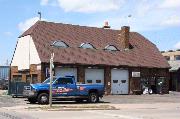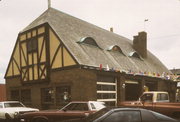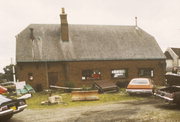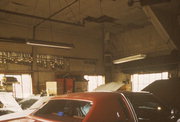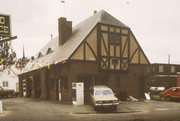Property Record
216 WASHINGTON ST
Architecture and History Inventory
| Historic Name: | Verbrick's Gas Station |
|---|---|
| Other Name: | |
| Contributing: | Yes |
| Reference Number: | 61294 |
| Location (Address): | 216 WASHINGTON ST |
|---|---|
| County: | Winnebago |
| City: | Menasha |
| Township/Village: | |
| Unincorporated Community: | |
| Town: | |
| Range: | |
| Direction: | |
| Section: | |
| Quarter Section: | |
| Quarter/Quarter Section: |
| Year Built: | 1935 |
|---|---|
| Additions: | |
| Survey Date: | 2009 |
| Historic Use: | gas station/service station |
| Architectural Style: | English Revival Styles |
| Structural System: | Unknown |
| Wall Material: | Brick |
| Architect: | Henry Auler |
| Other Buildings On Site: | |
| Demolished?: | No |
| Demolished Date: |
| National/State Register Listing Name: | Washington Street Historic District |
|---|---|
| National Register Listing Date: | 5/30/1986 |
| State Register Listing Date: | 1/1/1989 |
| National Register Multiple Property Name: |
| Additional Information: | In 1928 the Menasha Wooden Ware Company hired Oshkosh architectect Henry Auler to design a business district in the "English style of architecture." The district was to be located along Washington Street on part of the company's Doty Island stave yards, which were no longer in use after a production conversion from wooden tubs to corrugated paper shipping products. The plans were announced after the construction of the Washington Street Bridge and just prior to the construction of teh Tayco Street Bridge, both of which were expected to spawn a commercial resurgence and expansion of the western section of the central business district. The completion of the latter project would unify the width of Tayco Street to that of Washington Strete, allowing this corridor to better serve as part of U.S. Highway 41. The Auler plans called for a theater, garage, and various store buildings, three of which are known to have been constructed: the Inter City Oil Company Filling Station (demolished), Verbrick's Gas Statdion (216 Washington Stret), and the Northwest Electrotype and Engraving Offices and Plant (214 Washington Street). The rest of the district was never completed, perhaps due to the construction of the Brin Building (1 Main Street), which included the stores and theater called for in the Menasha Wooden Ware plan. The balance of the Doty Island stave yards was purchased by Marathon Corporation for a plant built in 1947. Built in 1935 by Norbert F. Verbrick, the gas station remained in the operation of the Verbrick family until 1984. Verbrick's Gas Station is of local historical significance for its association with the expansion of the central business district. Verbrick's Gas Station is located in the industrial city of Menasha, on the principal corridor of travel between Menasha and Neenah. Located on Washington Street, the gas station is a one story structure with a rectangular plan configuration and jerkinhead roof. The roofing materials are slate, the walls are brown brick with an American bond, and the foundations are concrete. The fenestration is irregular and includes various multi-paned windows and three eyebrow dormers. The front facade consists of three contemporary overhead garage doors and a corner office, which includes the principal entryway to the building. The gable ends are half timbered with stucco infill and a slight jetty projecting under the jerkinhead. Other features include a bracketed cornice over the office, beamed lintels, and a copper weathervane. Verbrick's Gas Station is a contributing member of the Washington Stret Historic District. Verbrick's Gas Station is of architectural significance as a fine example of Tudor Period design as applied to commercial use. It is one of four commercial buildings of Period design in Menasha and is one of two with Tudor references. The other commercial exmples are the United States Post Office (84 Racine Street), the Northwest Electrotype and Engraving Offices and Plant (214 Washington Street), and the Brin Building (1 Main Street). Each are fine examples of Colonial, Tudor, and Mediterranean Period designs, res[pectively. The Northwest Electrotype and Engraving Offices, the only other example of Tudor Period commercial design, can be differentiated by its foliated half timbering and other fine details. No photographs or drawings document the relative appearance of the Inter City Oil Company. Tudor Period residences can also be found on Lake Road and Nicolet Boulevard, but these are less distinguished than Verbrick's Gas Station, which imaginatively applies barn or carriage house forms to a contemporary utilitarian use. 2009--New white garage doors appear to be the only exterior change to the National Register-listed structure since it was last surveyed in 1984. |
|---|---|
| Bibliographic References: | A. Menasha Record; May 24, 1928, Page 1. B. Ibid.; April 23, 1928, page 1. C. Shattuck, S.F. History of Neenah. Privately printed, 1958. Neenah, Wisconsin. Page 332. D. Menasha Record; October 23, 1935; Page 1. |
| Wisconsin Architecture and History Inventory, State Historic Preservation Office, Wisconsin Historical Society, Madison, Wisconsin |

